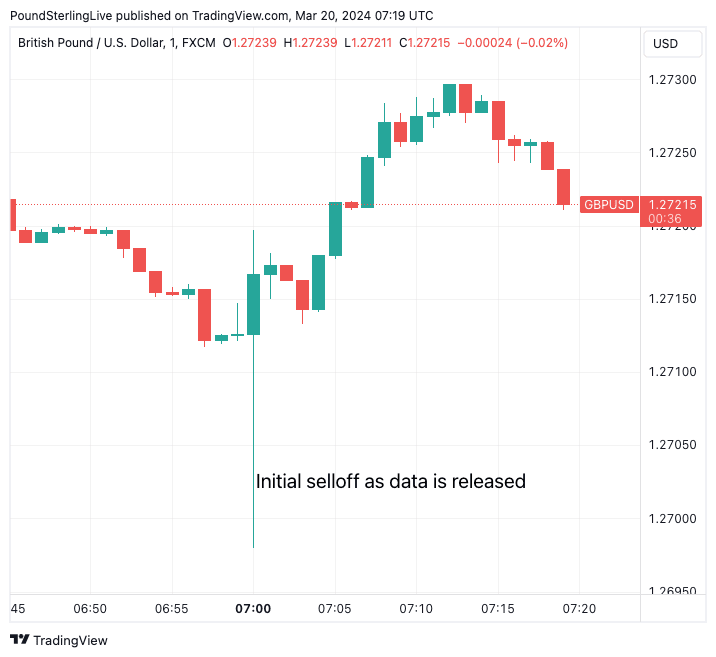Pound Defends Its Ground Despite Inflation Falling to Lowest Level Since 2021
- Written by: Gary Howes

The British Pound proved remarkably resilient after UK inflation figures undershot expectations, putting the Bank of England on course to cut interest rates in the summer.
The Pound to Euro exchange rate fell to 1.1684 in an initial reaction to news UK CPI inflation rose by 3.4% in the 12 months to February 2024, down from 4.0% in January and below the 3.6% expected by the consensus. This is the softest inflation print since September 2021, when it was 3.1%.
Core CPI (excluding energy, food, alcohol and tobacco) rose by 4.5% in the 12 months to February 2024, down from 5.1% in January and below expectations for 4.6%.
Services inflation - an important metric for the Bank of England - eased from 6.5% to 6.1%.
The Pound's initial selloff was reversed quite quickly, which is not the reaction we would expect when inflation numbers undershoot in this manner.
At the time of writing the Pound-Euro is back to 1.1707, which is close to where it was before the inflation data release. The Pound to Dollar exchange rate dipped to 1.2698 and zig-zagged before also settling close to pre-release levels.
Above: GBP/USD was volatile, albeit largely unchanged, following the inflation release. Track GBP with your own custom rate alerts. Set Up Here
"The slightly softer-than-expected UK inflation data prompted volatility in sterling FX’s initial reaction, gapping lower before recovering. The pound overall is a little lower versus the U.S. dollar and the euro," says Hann-Ju Ho, an economist at Lloyds Bank.
According to the ONS, the largest downward contributions to the monthly change in inflation came from food, restaurants and cafes, while the largest upward contributions came from housing and household services, and motor fuels.
These data come ahead of the Bank of England's Thursday policy announcement, which will see interest rates left unchanged at 5.25% and deliver updated guidance on the outlook.
Compare Currency Exchange Rates
Find out how much you could save on your international transfer
Estimated saving compared to high street banks:
£25.00
Free • No obligation • Takes 2 minutes
These most recent data could prompt one of the members of the Monetary Policy Committee who voted for a rate hike in February to join the majority who prefer rates to remain unchanged.
We would also look for another member to vote for a rate cut alongside Swati Dhingra. This would be a slightly 'dovish' signal consistent with the Bank gradually shifting towards a rate cut.
Inflation is expected to fall to below 2.0% in April due to a massive drop in energy prices, so markets are already positioned for downside inflation trends.
Yet, with services inflation still above 6.0% and core inflation well above the 2.0% target, the Bank of England will likely remain patient. An August rate hike is still the most likely start date.
This may explain why the Pound was remarkably resilient in the face of today's below-consensus figures.
The Pound was the second-best performer in 2023 and is the best performer of 2024, largely because interest rates have been set higher in the UK than elsewhere.
The outlook for the Pound and where it ultimately ends in 2024 depend on whether the UK interest rate advantage persists.
"Our view that inflation will fall below 2% in April and then ease towards 1% suggests the Bank may have to start cutting rates in the summer and reduce them to 3.00% next year rather than to 4.00% as expected by investors," says Paul Dales, Chief UK Economist at Capital Economics.
This view implies a substantive rerating in interest rate expectations and confirms that the Bank might have more room to cut than other peers (the U.S. Fed being the exception), which poses a downside risk to the Pound over the coming months, all thanks to an expected rapid retreat in inflation.





